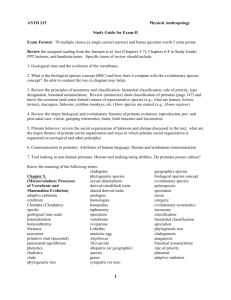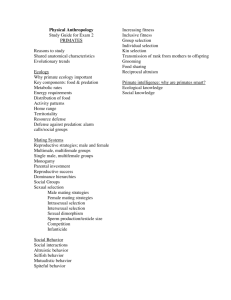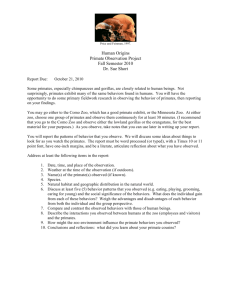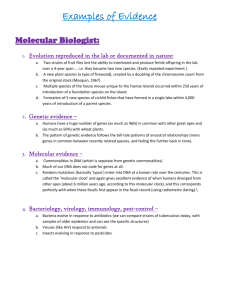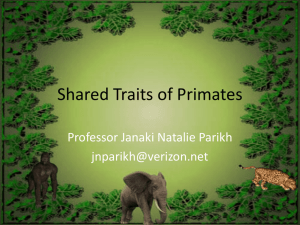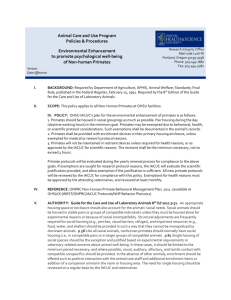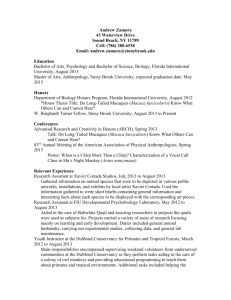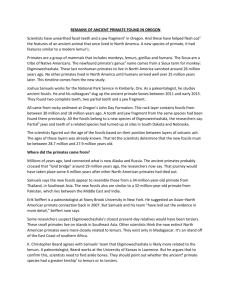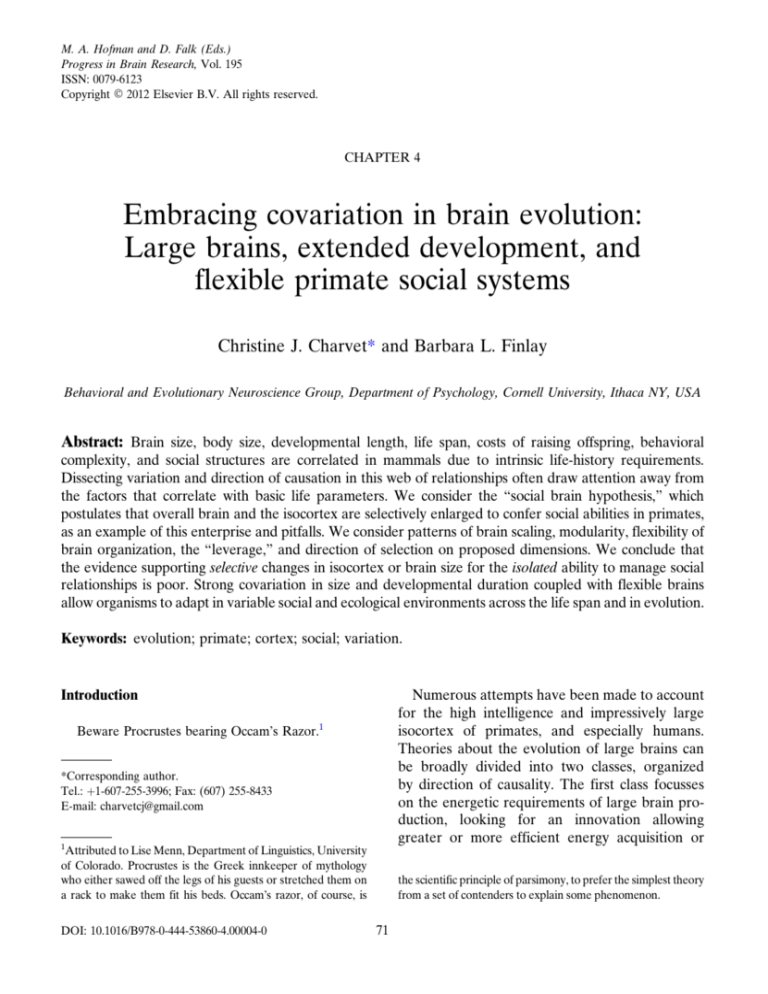
M. A. Hofman and D. Falk (Eds.)
Progress in Brain Research, Vol. 195
ISSN: 0079-6123
Copyright Ó 2012 Elsevier B.V. All rights reserved.
CHAPTER 4
Embracing covariation in brain evolution:
Large brains, extended development, and
flexible primate social systems
Christine J. Charvet* and Barbara L. Finlay
Behavioral and Evolutionary Neuroscience Group, Department of Psychology, Cornell University, Ithaca NY, USA
Abstract: Brain size, body size, developmental length, life span, costs of raising offspring, behavioral
complexity, and social structures are correlated in mammals due to intrinsic life-history requirements.
Dissecting variation and direction of causation in this web of relationships often draw attention away from
the factors that correlate with basic life parameters. We consider the “social brain hypothesis,” which
postulates that overall brain and the isocortex are selectively enlarged to confer social abilities in primates,
as an example of this enterprise and pitfalls. We consider patterns of brain scaling, modularity, flexibility of
brain organization, the “leverage,” and direction of selection on proposed dimensions. We conclude that
the evidence supporting selective changes in isocortex or brain size for the isolated ability to manage social
relationships is poor. Strong covariation in size and developmental duration coupled with flexible brains
allow organisms to adapt in variable social and ecological environments across the life span and in evolution.
Keywords: evolution; primate; cortex; social; variation.
Numerous attempts have been made to account
for the high intelligence and impressively large
isocortex of primates, and especially humans.
Theories about the evolution of large brains can
be broadly divided into two classes, organized
by direction of causality. The first class focusses
on the energetic requirements of large brain production, looking for an innovation allowing
greater or more efficient energy acquisition or
Introduction
Beware Procrustes bearing Occam’s Razor.1
*Corresponding author.
Tel.: þ1-607-255-3996; Fax: (607) 255-8433
E-mail: charvetcj@gmail.com
1
Attributed to Lise Menn, Department of Linguistics, University
of Colorado. Procrustes is the Greek innkeeper of mythology
who either sawed off the legs of his guests or stretched them on
a rack to make them fit his beds. Occam’s razor, of course, is
DOI: 10.1016/B978-0-444-53860-4.00004-0
the scientific principle of parsimony, to prefer the simplest theory
from a set of contenders to explain some phenomenon.
71
72
utilization, assuming the benefits of a large brain
to be manifest (e.g., the expensive-tissue hypothesis, Aiello and Wheeler (1995); the radiator
hypothesis, Falk (1990) and Falk and Gage
(1998); the introduction of cooking, Carmody
and Wrangham (2009); the conscription of
alloparental care, Isler and Van Schaik (2009)).
These theories have intrinsic bidirectional,
“racheting,” or exaptive aspects explored by their
authors. In the case of the “expensive-tissue”
hypothesis, reallocation of metabolic costs from
gut to brain permits a larger brain to be
supported, enhancing memory for the location
and seasonality of high-quality foods, which then
allow further increases in brain size, and so forth.
In the case of fire use for food preparation, selection for the cognitive competency to produce fire
not only allows more nutrients to be extracted
from foodstuffs but also ritualizes eating as an
intrinsically social activity. Biparental care for
young allows more numerous and/or larger offspring but also immediately provides more
opportunities for learning from conspecifics, typically over a longer period. We argue here that the
multiple types and levels of causality embedded
in most of these scenarios should be acknowledged at the outset.
The second class of theories about primate
brain size and intelligence focusses on the selection for specific behavioral or cognitive competencies as the essential change in brain
organization (e.g., the social brain hypothesis,
Dunbar (1992); symbol-making, Deacon (1990);
recursion in the language facility, Hauser et al.
(2002); and many more, Finlay (2007) and Sherwood et al. (2008)). We examine a particular
hypothesis, the social brain hypothesis, as
emblematic of this approach, not as a theory per
se deserving of special criticism! We will argue
that a focus on brain size and a specific behavioral
adaptation neglects to consider coordinated
variations in developmental schedules, body,
brain, and brain region size. This focus is so much
an obligatory feature of the basic discriminative
methods of analysis anthropologists and
comparative anatomists have been using, that it
rarely receives any scrutiny. These tactics simultaneously focus attention not only away from the
wide variations in social systems within species
but also away from the necessary coordination
and covariance of changes in size (i.e., body,
brain, brain region) and developmental duration
across species. We conclude that brain or isocortex size is unlikely to have selectively expanded
to manage social systems as many energetic, ecological, and behavioral factors together coordinate changes in development and brain
structure. We argue that it is essential to consider
the coordinated nature of variations in size and
time between and within species to understand
human brain evolution.
The social brain hypothesis
The social structure of primates is highly diverse.
Some primates are monogamous, while other
primates are polygamous or polyandrous (Smuts
et al., 1986). Some primates live in groups forming
simple or complex social hierarchies, while other
primates are mainly solitary (Smuts et al., 1986).
The finding that brain size and specifically the relative size of the isocortex positively correlate with
group size has been used to argue that bigger
groups require large brains and larger isocortices
to manage social relationships (Dunbar, 1992,
1993, 2009; Dunbar and Shultz, 2007a,b; Lehmann
and Dunbar, 2009; Shultz and Dunbar, 2007).
In support of this hypothesis is the finding that
the residuals of a phylogenetically controlled linear regression between brain and body size were
found to positively correlate with aspects of social
structure and behavior related to group size in
primates (Pérez-Barbería et al., 2007). Moreover,
the size of the isocortex, in particular, relative to
the rest of the brain, was found to positively correlate with group size in primates (Fig. 1; Dunbar,
1992). Taken together, these correlative analyses
have been used to argue that larger brains and
proportionately enlarged isocortices endow
(a)
105
Body weight (kg)
104
103
102
101
100
10–1
6 7 89
2
3
4
5 6 7 89
1
2
3
4
5 6
10
Group size
(b)
Brain volume (mm3)
106
4
2
105
4
2
104
4
2
6 7 89
1
2
3
4
5 6 7 89
10
2
3
4
5 6
2
3
4
5 6
Group size
(c)
Isocortex volume (mm3)
106
105
104
103
6 7 89
1
2
3
4
5 6 7 89
10
Group size
(d)
4
Isocortex ratio
3
2
1
9
8
6 7 8 9
1
2
3
4
5 6 7 8 9
10
2
3
4
5 6
Group size
Fig. 1. Body weight (a), brain volume (b), isocortex volume (c), and the size of the isocortex relative to the rest of the brain (d) are
regressed against group size in primates. Open diamonds are averages of species. Data are from Dunbar (1992); isocortex volume is
gray matter with a white matter component as detailed in Stephan et al. (1981).
74
primates with increased cognitive “computational
power” to manage larger number of possible social
interactions and relationships (Dunbar, 1992, 1993,
2009). Although these analyses attempt to correct
for possible confounds in cross-species variations
in overall brain and body size, the analyses used
to support the social brain hypothesis neglect to
consider the behavioral setting of allometric and
developmentally coordinated changes in brain
region size: to consider the brain’s intrinsic
plasticity and its fundamental role in learning and
adapting to both physical and social environments.
In addition, the magnitude of the residualized
change in brain size attributable to discriminable
social factors or identified behavioral capacities
of any kind in most cases is extremely small
compared to the range over which brains vary.
This notable and persistent discrepancy has
caused speculation that there might be “two kinds”
of size: shared and unshared (residualized) variation in brain size might be physically distinct
in some way (Aboitiz, 1996). This is an interesting
idea, but one that still has no empirical support.
Coordinated changes in time and size
Overall body size varies widely between primate
species ranging from 56g in gray mouse lemur
(Microcebus murinus) to 105kg in gorillas
(Gorilla gorilla). The brain occupies 3% of the
overall body volume in the gray mouse lemurs
compared with 0.4% of the overall body in
gorillas (Stephan et al., 1981). Well-known comparative analyses of brain and body size across
mammalian species show that the overall brain
size scales with a negative allometry when
regressed against the body (Armstrong, 1982;
Jerison, 1973; Jerison, 1979). That is, as bodies
expand, brains get proportionately smaller.
The size of the isocortex also varies widely
between primate species ranging from 0.74cm3 in
the gray mouse lemur to approximately 1000cm3
in humans (Stephan et al., 1981). The size of
the isocortex occupies only 44% of the overall
brain in the gray mouse lemur compared to
80% of their entire brain in humans (Homo
sapiens; Stephan et al., 1981). It might therefore
seem reasonable to assume that the proportionally enlarged isocortex of humans sets us apart
from other primates. However, it has long been
established that the size of the brain of humans,
and the isocortex particularly, is an allometrically scaled-up version of its close relatives
(Hofman, 1989, See Chapter 18).
Mammalian and nonmammalian vertebrates
exhibit a conserved pattern of brain scaling
(Figs. 2 and 3; Darlington et al., 1999; Finlay et al.,
2011; Finlay and Darlington, 1995; Reep et al.,
2007; Yopak et al., 2010). Some brain regions
(e.g., medulla) scale with a negative allometry
when regressed against the rest of the brain.
Other brain structures such as the isocortex scale
with a positive allometry when regressed against
the rest of the brain (Finlay and Darlington,
1995) so that as mammalian brain sizes expand,
the more they come to be dominated by the volume of the isocortex (Fig. 4).
Isocortical subdivisions vary widely between primate species. For instance, the frontal cortex
occupies 19% of the overall brain in a monk sakai
(Pithecia monachus), whereas the frontal cortex
occupies approximately 42% of the overall brain
in humans (Smaers et al., 2010, 2011). Isocortical
regions, such as “primary visual cortex” or “frontal
cortex” (variously defined), also exhibit distinct
allometric scaling with the rest of the isocortex
(Fig. 3; Bush and Allman, 2004; Kaskan et al.,
2005; Smaers et al., 2010, 2011). Other isocortical
subdivisions (e.g., primary somatosensory isocortex) scale with a negative allometry when
regressed against the rest of the isocortex (Fig. 3;
Kaskan et al., 2005). Taken together, these findings
demonstrate that as primate brains get bigger, the
isocortex and, in particular, the frontal and visual
cortices become disproportionately enlarged relative to the rest of the brain.
75
(a)
Brain volume (mm3)
106
105
104
103
Haplorhine primates
Strepsirhine primates
Other mammals
102
101
Isocortex volume (mm3)
(b)
102
103
Body weight (g)
104
105
106
105
104
103
102
101
102
103
104
105
Rest of the brain (mm3)
Fig. 2. Brain volume as a function of body weight (a) and isocortex volume as a function of the rest of the brain (b) in primates and
other mammals. These data show that the overall brain and isocortex size is disproportionately expanded in primates relative to
many other mammals, but that the size of the brain and isocortex strongly covaries within taxonomic groups. Data are from
Stephan et al. (1981).
How might these coordinated changes in body,
brain, and brain region size arise in development?
Finlay and Darlington (1995) have argued that the
conserved pattern of brain scaling is mirrored in a
conserved pattern in the sequence of developmental events. Allometric variations in adult brain size
arise because of the exponential increase in the progenitor pool population when developmental
schedules lengthen. That is, progenitor cells that
exit the cell cycle late in development benefit from
an exponential multiplication of cells relative to
progenitor cells that exit the cell cycle early in
development (Finlay et al., 2001). The effect of
stretching developmental schedules is that
structures that are born late in development (e.g.,
isocortex) become proportionately enlarged relative to the overall brain.
We should emphasize here that we are not
using this description of development as an argument for overwhelming “developmental constraint,” brain or behavioral uniformity, but
rather to lay out the reasonably simple basis for
the nonlinear behavior of the vertebrate brain
“Bauplan” as it enlarges. Within the context of
this Bauplan, new phenotypes emerge, arising
from such diverse developmental mechanisms as
(a)
Region volume (mm3)
105
104
103
102
Frontal gray matter
Primary visual cortex
Primary auditory cortex
101
103
104
105
106
Isocortex volume (mm3)
Frontal gray volume (mm3)
(b)
105
104
103
Primates
Other mammals
102
103
104
105
Rest of the isocortex volume (mm3)
(c)
V1 volume (mm3)
104
103
102
Primates
Other mammals
101
102
103
104
105
Rest of the isocortex volume (mm3)
(d)
2
A1 volume (mm3)
1000
4
2
100
4
2
Primates
10
Other mammals
4
103
104
105
Rest of the isocortex volume (mm3)
Fig. 3. Isocortical regions are plotted against the overall isocortex volume (a) or the rest of the isocortex volume (b–d) in several
mammalian species. The frontal gray matter and the primary visual cortex (V1) expand faster than the size of the primary
auditory cortex (A1) as overall brain size increases. These observations suggest that various isocortical regions expand with a
distinct allometry. Data are from Kaskan et al. (2005) and Smaers et al. (2010).
77
(a)
(b)
4
106
Isocortex ratio
Isocortex volume (cm3)
3
105
104
1
Haplorhine primates
Strepsirhine primates
9
8
7
103
103
2
3
4 5 6 78
104
2
3
4 5 6 78
105
2
2
Rest of the brain (cm3)
103
2
3
4 5 6 7
104
2
3
4 5 6 7
105
2
Rest of the brain (cm3)
Fig. 4. Isocortex volume (a) and isocortex volume relative to the rest of the brain (b) are plotted against the rest of the brain (i.e.,
brain–isocortex) in haplorhine and strepsirhine primates. As brains expand, the isocortex becomes disproportionately enlarged in
strepsirhine and haplorhine primates. This is evident from the observation that the relative size of the isocortex increases as the
rest of the brain expands. Data are from Stephan et al. (1981).
changing rates of cell division (Charvet et al.,
2011), early alterations in gene expression
patterns that specify brain regions (McGowan
et al., 2010; Menuet et al., 2007; Sylvester et al.,
2010), heterochronic shifts of “clocks” of cell
specification with respect to the establishment of
precursor pools to change neuron proportions
(Finlay, 2008; Dyer et al., 2009), and extended
or limited receptor distributions altering motivational strengths (Young and Wang, 2004). Rather
than ignoring “common variance” in brain size by
examining residuals, we argue that the stability of
this fundamental plan is so strong that it demands
a functional explanation of its own.
Variation in size and time
Selective changes in brain region size between
taxonomic groups are called grade shifts (Barton
and Harvey, 2000). Primate suborders exhibit
a number of grade shifts in brain and brain
region size. Haplorhine primates (i.e., new-world
and old-world monkeys and apes) exhibit a disproportionately enlarged brain and a disproportionately enlarged isocortex relative to that of
strepsirhine primates (i.e., lemurs, lorises,
galagos; Figs. 2 and 4; Barton and Harvey, 2000;
Finlay et al., 1998; Stephan et al., 1981). Both
haplorhine and strepsirhine primates exhibit a
disproportionately enlarged isocortex relative to
many other mammals. However, within each primate suborder, the size of the isocortex is
extremely predictable when regressed against
the rest of the brain (Fig. 2).
Comparative developmental studies in primates
and other mammals show that the grade shifts just
described in isocortex size may arise due to selective alterations in the timing of developmental
schedules. Comparative analyses of isocortex generation and development showed that haplorhine
primates (i.e., rhesus monkeys, humans) selectively delay isocortical neurogenesis compared to
rodents (i.e., rats, mice, hamsters, spiny mice,
guinea pigs; Clancy et al., 2000, 2001, 2007; Finlay
et al., 1998). Relative delay in isocortical neurogenesis entails that the isocortical progenitor
pool population will multiply exponentially relative to other nondelayed structures and the isocortex will expand in neuron number and size.
Note that we have described at this point two separate, but logarithmically additive, ways of
increasing relative cortex size. Increase in duration of development alone to produce a larger
brain, with rate of cell production unchanged,
automatically increases the relative proportion
78
of the isocortex. The primate isocortex expands
disproportionately still more, adding to the fundamental nonlinearity of allometric scaling an
increase in the dedicated precursor cell pool for
the cortex, by delaying isocortical stem-cell cessation with respect to the schedule established in
rodents and insectivores, and thereby producing
a “grade shift.”
Some intrinsic difficulties on the use of residuals
and ratios in allometric studies
In a series of studies beginning in the early 1990s,
Dunbar and his colleagues showed that the relative size of the isocortex or brain size and
residuals derived from a linear regression of brain
and body size positively correlate with group size
or related measures of group size in primates
(Dunbar, 1992, 2009; Dunbar and Shultz, 2007a,b;
Pérez-Barbería et al., 2007). In parallel with statistical practices in the field, the first studies looked
at basic regressions between two variables. The
next set of studies used more elaborate multiple
regression techniques and phylogenetic contrasts
to eliminate the statistical problem of non-independence of taxonomic relationships. Recent studies attempted to determine aspects of temporal
emergence of the correlated features examined
using discretized variables in conjunction with
extensive phylogenetic analyses (Pérez-Barbería
et al., 2007). As statistical analyses flourish, it is
rare to see any representation of primary data,
and the basic “visual” sense of the strength of association, magnitude of results, or amount of variation has tended to fade. In this chapter, following
the historical progression of the analyses
described, we will plot the basic data relating
brain, body, and group size in primates, then add
in taxonomic variability, and finally consider the
range of variation and a few of the measurement
issues in group size, but will go back and plot the
basic data on which these claims are established.
We should emphasize that we do not contest that
there is a relationship between relative brain size,
and (possibly) relative isocortex volume and social
complexity, generally speaking. The sophistication
of the statistical analyses is undoubted. What we
do contest are the basic assumptions of the techniques, the causal relationships implied, and the
claim that the relationship between social competence and relative brain size, compared to any of
a number of other measures of behavioral complexity, is unique.
First, we describe problems with statistical comparisons between groups involving basic allometric
relationships between brain parts, to set out very
basic issues, which antedate the social brain
hypothesis. A number of studies examining the
potential mechanisms underlying species-specific
adaptations or developmental disorders have
focused on the relative sizes of parts of the brain.
The initial problem (not a problem of the social
brain studies) is “relative to what”? For example,
suppose it is shown that the relative size of the
frontal cortex is greater in autistic individuals
relative to healthy individuals (Carper and
Courchesne, 2005; Courchesne et al., 2011), even
correcting for a somewhat greater brain size in the
autistic group by taking a ratio of frontal cortex to
brain volume overall. If individual variation in
humans follows primate brain allometry, increases
in brain size will produce an even greater increase
in the proportion of cortex, and frontal cortex will
be a greater proportion still (Fig. 4). “Correcting”
for brain size by taking a simple ratio of frontal cortex to brain size between two groups with differing
brain sizes will invariably demonstrate relatively
more frontal cortex in the group with the larger
mean brain size, but this is simply a predictable outcome of the underlying allometry and no indication
of any unusual hypertrophy or pathology of the
frontal cortex. Although this problem plagues a
number of comparative studies in which two species
are compared, or brains with a developmental disorder that are compared to normal brains, fortunately,
for studies of primate brain evolution, we have
ample information to be able to predict the different
allometries of various brain divisions.
79
Residuals log (brain vol/body wt)
The use of residuals derived from allometric
equations relating the size of two structures is a
common method to compare brain region size
across species. In the case of the social brain
hypothesis, the finding that residuals derived from
the linear regression between brain and body size
correlates with group size must account for grade
shifts in brain size between haplorhine and strepsirhine primates, and when that is done, a significant statistical relationship remains (PérezBarbería et al., 2007). The brains of haplorhine
primates are disproportionately enlarged relative
to those of strepsirhine primates. However, brain
and body size strongly covary within haplorhine
and strepsirhine primates. Fitting a linear regression through brain and body size in primates
(haplorhines and strepsirhine primates) would fit
a linear regression with a different slope and intercept than those obtained by fitting two separate
linear regressions through the brain and body of
haplorhine and strepsirhine primates (Fig. 5).
Returning to the basic data, we look at the amount
of association between relative brain size and
social group size in these two taxonomic groups.
In the case of the social brain hypothesis, the brain
versus body residual values obtained for both
haplorhine and strepsirhine primates correlate
more strongly with group size than does the brain
versus body residual values derived from separate
linear regressions for haplorhine versus strepsirhine primates (Pérez-Barbería et al., 2007).
However, the correlation coefficients derived from
the residuals of brain to body size in both scenarios
are surprisingly low, and it would appear that
something about the grade shift in relative
brain and cortex size between these two taxa is
accounting for most of the effect. Further analyses
from the same laboratory group and others considering phylogenetic contrasts, other behavioral
measures, and more elaborate statistics generally
50
r 2 = 0.12
0
r 2 = 0.02
–50
–100
Residuals for both haplorhine and strepsirhine primates
Residuals for haplorhine vs. strepsirhine primates
10
20
30
40
50
60
Average group size
Fig. 5. Residuals derived from a linear regression through the brain size and body size are correlated against group size in
primates. In one scenario, residuals are derived from a linear regression through the brain and body size of both haplorhine and
strepsirhine primates (red line). In another scenario, residuals are derived from two separate linear regressions derived for
haplorhine and strepsirhine primates (blue line). The correlation coefficient between group size and brain versus body size
residual values derived from both haplorhine and strepsirhine primates is higher than the correlation coefficient between group
size and brain versus body size residuals obtained for strepsirhine and haplorhine primates. Data are from Pérez-Barbería et al.
(2007). Although the authors examined the geometric means rather than the arithmetic means of primate group size, the low
correlation coefficients between group size and brain versus body size residuals in primates do not support the claim that group
size correlates with brain size in primates.
80
demonstrate a statistically significant but clearly
very small effect in residual change in brain size
(Barton, 1993; Dunbar, 1993).
We return to the basic data in Fig. 1 of the regressions of primate body, brain isocortex volume,
and “isocortex ratio” with group size (taken from
Dunbar, 1992). The social brain hypothesis posits
that isocortex (either volume or ratio) and group
size are positively correlated (isocortex volume
residualized with respect to both body size and brain
volume). Of interest here is the relationship of body
size to social group size, which opens the possibility
of many other causal routes between brain size and
group size than the ones mentioned here—for example, niche, range size, and type of food consumed.
Further, consider other behaviors demonstrated to
vary with brain size: “innovation” in the wild, successful invasion of new territories, residual mortality
when corrected for body size, and laboratory
measures of learning ability. These all correlate with
each other and with relative brain size (GonzálezLagos et al., 2010; Lefebvre and Sol, 2008; Lefebvre
et al., 2002; Reader et al., 2011). The strength of the
association between isocortex size and group size
that would be left after partialling out capability
to innovate, or general learning ability, seems
unlikely to be significant. Put another way, we would
suggest that virtually any reasonable measure of
cognitive or behavioral complexity—working memory grammatical sequence learning, innovation and
so on—would show the same relationship to relative
brain size.
Variation in social structure within a species
The size of social systems and social structures
varies widely within a species. Humans form
groups that are variable in size (Dunbar, 1993;
Zhou et al., 2005). Some humans are polygamous
or polyandrous, whereas others are monogamous.
Some humans pair-bond with a single individual
for life, while others pair-bond for short
bouts. Given the variation in social structure
within humans, it seems difficult to assign a
specific sociality index or group size to humans.
Indeed, Dunbar has refrained from estimating
group size in humans (Dunbar, 1993). Instead,
estimation of group size for humans is based on
analyses of group size and brain size of nonhuman primates.
Strepsirhine primates are considered to be solitary or form small groups. In contrast, haplorhine
primates are thought to aggregate in large groups.
However, there is considerable variation within
species in each of these taxonomic groups (Fig. 6;
Smuts et al., 1986). Among strepsirhine primates,
lemurs such as the white sifaka (Propithecus verreauxi) have been observed to be solitary but they
may also form groups of up to 13 individuals
(Smuts et al., 1986). Among haplorhine primates,
rhesus monkeys form groups that range from
nine to well over 100 individuals (Berman et al.,
1997; Smuts et al., 1986). Gorillas are considered
to form large and complex social systems but
some members of these species are actually
solitary (Smuts et al., 1986). Collectively, these
observations suggest that the size of social system
varies widely within a species and that estimates
of mean group size neglect to consider the wide
variation in the size of social systems within each
primate species.
Food resource distribution contributes systematically to social organization in vertebrates generally, and mammals and primates specifically
(Chapman, 1990a). Resource availability in part
determines the decision of birds to contribute
alloparental care to relatives, rather than to seek
independent reproduction (Emlen, 1974). For
instance, in primates, it has been reported that spider monkeys (Ateles geoffroyi) from Costa Rica
vary from 1 to 35 individuals and 50% of the variance in mean subgroup size can be predicted from
the size, density, and distribution of food patches
(Chapman, 1990b). These observations suggest
that primates are actually highly flexible in modifying the size of their social system in response to
resource availability. In the case of humans
(Betzig, 2009), it has been persuasively argued
that, in cases where resources are physically
81
2
100
Group size
6
4
2
10
6
4
2
1
1.0
1.5
2.0
Isocortex ratio
2.5
3.0
Fig. 6. The range of reported group size within primates is plotted against the relative size of the isocortex. These data show that
group size varies extensively within primate species. Data on group size ranges are from Izawa (1976), Smuts et al. (1986), Koenig
(1995), and Higham et al. (2009).
stationary, and can be monopolized, as in traditional agrarian societies, the resulting social structure can be characterized as “eusocial,” with
reproductive activity limited to a few individuals,
who can control large harems, with explicitly
designated nonreproductive castes.
The social brain hypothesis, quite obviously,
does not argue for a complete absence of contribution of other factors to group size, but only for a
constraint on maximal tolerable group size related
to brain size. When the actual range of natural variation in primate societies is considered, however,
the conceptualization of how any individual might
be selected on to cope with a particular group size
becomes suspect, and the kind of explanations
offered seem more like general capacity arguments, rather than a numerical limit on the number
of individuals to be remembered.
Constancy in size and time within a species: An
unusual example from human pygmies
Developmental schedules in primates, and
mammals generally, subsuming brain growth, body
growth, maturational milestones, and life span are
very highly intercorrelated. Moreover, the initial
production of brain tissue is exceptionally
predictable as a constant function per unit time
(Passingham, 1985), and brain volume, both relative and absolute, is highly correlated with life span.
For example, several studies have shown that
variations in body size are associated with
variations in postnatal growth, life-history
schedules, and life expectancy within humans and
across species (Charnov, 1991; Migliano et al.,
2007; Nettle, 2010). One recent study showed that
human pygmies from two different continents
reach adult stature and sexual maturity and die earlier than taller individuals (Fig. 7; Migliano et al.,
2007). These findings suggest that size, developmental schedules, as well as the overall life span
length covary within a species. It is not clear what
factors might have caused changes in size, developmental schedules, and the overall life span in
pygmies, but there is no evidence that we know of
to suggest that a simple social structure or a reduced
social system in pygmies caused them to be smaller
than taller individuals, or the reverse.
Constancy in brain architecture fosters
variation in brain function
The plasticity of the isocortex described in present neuroscience work, and in functional imaging,
82
160
Height (cm)
145
130
115
Biaka
Aeta
Turkana
Massai
100
85
3
6
9
12
Age (years)
15
18
21
Probability of survival at birth
(b)
(a)
Biaka
Aeta
Ache
!Kung
0.8
0.6
0.4
0.2
0
15
30
45
60
75
Age (years)
Fig. 7. The Biaka and Aeta are taller than Turkana, Massai, Ache, and !Kung. (a) Biaka and Aeta reach adult height later than
Turkana and Massai. (b) Biaka and Aeta have a reduced survival probability at birth than Biaka and Aeta do. Data are from
Migliano et al. (2007).
is increasingly at odds with the specificity and
modularity of brain function that is often presumed in studies relating brain region size to specific cognitive abilities—this enterprise termed
“neuroecology.” There is tremendous plasticity
in what sensory modalities a brain region may
process. It is well known that the visual cortex
or auditory cortex may reallocate function to process information from other modalities in the
absence of visual input or auditory input. Experimental studies have found that early removal of
large regions of the visual cortex, superior
colliculus, and the brachium of the inferior
colliculus of developing ferrets gives rise to a
novel and functional visual pathway that projects
through the medial geniculate nucleus to the primary auditory cortex (Roe et al., 1993; Sur
et al., 1988). In naturally blind humans, functional
magnetic resonance imaging studies show
increased blood oxygen level-dependent (BOLD)
signals in the visual cortex during tactile discrimination (Sadato et al., 1996; Sathian and Stilla,
2010), auditory-spatial tasks (Collignon et al.,
2011), and sentence comprehension tasks (Bedny
et al., 2011). Reallocation of function is not
restricted to long-term deprivations of one
sensory modality. Short-term loss of vision also
leads to increased BOLD signal in the occipital
cortex during tactile discrimination tasks
(Kauffman et al., 2002; Merabet et al., 2008). Collectively, these observations suggest that there is
tremendous flexibility in processing information
from various modalities. We argue that this flexibility allows organisms to respond to changing
social and environmental situations throughout
the life span.
At the core of the social brain hypothesis is the
assumption that primates with larger isocortices
can manage social groups because they have
more cognitive capacity for social information
than primates that form smaller groups. Does this
claim about specific intelligence track well onto
specific abilities subserved by cortical areas in
humans? Unfortunately, there is little connection
between these literatures. In particular, it has
been suggested that the size and activation of
frontal and temporal isocortices correlate with
basic measures of intelligence in humans. In support of this argument is the finding that the
size of the isocortex and activation of the frontal
and temporal cortices correlate with measures
of intelligence and social cognitive performance
83
in humans (Jung and Haier, 2007; Powell et al.,
2010). However, the isocortex obviously mediates
more behaviors involved in social situations, and
social behaviors are mediated by a multitude of
brain regions (Anderson, 2010). Within the temporal cortex, Broca’s area is a neural substrate
for the perception and production of speech.
However, Broca’s area is also involved in other
tasks such as imitation (Makuuchi, 2005), anticipation of movement, and imagery of motion
(Binkofski et al. 2000). Therefore, the finding that
activation and size of the isocortex is correlated
with measures of intelligence or social cognitive
performance does not, in and of itself, show
that the expanded isocortex confers specific
increased cognitive abilities to manage social
situations.
Predictable relationships in brain architecture
and brain size
Coordinated variations in developmental length,
life span, and brain size appear to have evolved
in a number of mammalian taxa. Instances of convergent evolution suggest that this covariation
may be intrinsically linked. Similar to haplorhine
primates, elephants and cetaceans exhibit an
extended period of development, an extended life
span, and a large brain (Armstrong, 1982; Haug,
1987; Hofman, 1983, 1993). The observation that
elephants and cetaceans differ from their sister
groups and most other mammals in being large
and having prolonged developmental periods
and extended life spans suggests that changes in
time and size have evolved together multiple
times.
Elephants and cetaceans are considered to be
among the longest-lived mammals. Among
cetaceans, whales such as the bowhead whale
(Balaena mysticetus) have been estimated to live
over 100 years (George et al., 1999). The Asian
elephant (Elephas maximus) exhibits some of the
longest recorded life spans of land animals, with
an estimated maximum life span of approximately
65–86years (Weigl, 2005; Wiese and Willis, 2004).
Elephants and whales not only exhibit extended
life spans, but they also exhibit extended periods
of postnatal development. For instance, the Asian
elephant reaches adult stature at around 17 years
of age and it is estimated that the bowhead whales
reach sexual maturity after 22 years of age
(George et al., 1999). Bowhead whales are among
the largest animals weighing 100,000kg and adult
Asian elephants are among the largest land
animals weighing approximately 3000kg. The
finding that some elephants and cetaceans are
among the largest and most long-lived animals
suggests that these taxa expanded and prolonged
the duration of developmental length and life span.
Taken together, these observations suggest that
time and size vary together. The coordinated variation in size and time may entail predictable consequences for behavior.
Some elephants, cetaceans, and primates are
well known for their cooperation. We argue that
an extended duration of postnatal development
entails an extended period of postnatal parental
care, which may foster affiliate behavior and cooperation directed toward juveniles or adult group
members. In support of this argument is the observation that some primates and elephants not only
receive parental care, but they also receive
allomaternal or alloparental care (Lee, 1997;
Rapaport and Haight, 1987; Riedman, 1982).
Some elephants and primates display evidence of
life-long affiliate and cooperative behavior toward
kin (Langergraber et al., 2007) and nonkin (de
Waal et al., 2008; Langergraber et al., 2007;
Plotnik et al., 2011). Evidence that long-life
histories covary with animal cooperation is also
found among nonmammalian vertebrates such as
corvids (Møller, 2006; Seed et al., 2008). Taken
together, these findings suggest that species that
exhibit long-life histories also exhibit evidence of
animal cooperation and affiliate behavior. However, it is not clear if sociality may foster coordinated changes in the organism’s overall size,
brain size, or cortex size. It is possible that coordinated changes in developmental schedules foster
84
changes in social behavior, and the record of that
learning process is the mature isocortex.
Causal scenarios, which depend on covariation,
give development a central role
We now return to the bidirectional forms of brain
change described in the introductory sections and
develop some causal scenarios, which may link
the morphological and general behavioral capacities under consideration here. Particularly, we
are interested in those behaviors, which allow
the brain to play a causal role in its own construction. In primates, big bodies and big brains take
longer to make and require more resources.
Those larger primate infants are necessarily going
to have a longer developmental period to learn in,
and because their larger brain size is likely to be
associated with biparental or possibly alloparental
care, more individuals populate its extended
developmental period, both at any moment and
over time. This extended learning period may
enable these large infants to better develop the
categorization skills to differentiate individuals
and their motivations, learn elaborate methods
of food processing, or learn the unique characteristics and affordances of foraging sites,
depending on what the social and natural ecology
presents. By its essential, covarying nature, however, a big-brained mammal has an extended
developmental period, populated by at least one
and often many caretakers, which will make social
complexity in large-brained creatures a high probability. While we are uncertain whether group
size per se is a good measure of a broader notion
of social complexity, which must certainly be a
multivariate entity, we suggest that the real
mediating variable between brain size and behavioral complexity might be developmental time,
and not simply the number of neurons available
to discriminate individuals.
This view of brain evolution is quite distinct
from the one that emerges from the differentiating,
residual variance view of brain part evolution.
In the view of brain evolution set out by Dunbar
and colleagues, additional brain goes directly to
improve capacity limitation on the ability to either
remember or orchestrate the interactions of a set
number of individuals, a direct mapping of a social
problem defined numerically to a volume of committed tissue. In our view, the extended developmental schedule required to make a large brain
and the size of the brain itself must be considered
as one variable. The extreme conservation of this
relationship across mammals suggests that there
have been few advantages in attempts to decouple
rate of production and size of the end product. The
motivations each developing organism brings
to the environment in combination with its plastic
brain allow the information represented in
the physical and social environment to construct
the mature organism on which natural selection
will act.
Acknowledgments
This work was supported by an NSF grant
#0849612 to B. L. F. and by the Eunice Kennedy
Shriver National Institute of Child Health and
Human Development fellowship #F32HD067011
to C. J. C. The content is solely the responsibility
of the authors and does not necessarily represent
the official views of the Eunice Kennedy Shriver
National Institute of Child Health and Human
Development or the National Institutes of
Health.
References
Aboitiz, F. (1996). Does bigger mean better? Evolutionary
determinants of brain size and structure. Brain, Behavior
and Evolution, 47, 225–245.
Aiello, L. C., & Wheeler, P. (1995). The expensive-tissue
hypothesis: The brain and the digestive system in human
and primate evolution. Current Anthropology, 36, 199–221.
Anderson, M. L. (2010). Neural reuse: A fundamental organizational principle of the brain. The Behavioral and Brain
Sciences, 33, 245–266 discussion 266–313.
85
Armstrong, E. (1982). A look at relative brain size in
mammals. Neuroscience Letters, 34, 101–104.
Barton, R. A. (1993). Independent contrasts analysis of neocortical size and socioecology in primates. The Behavioral
and Brain Sciences, 16, 694–695.
Barton, R. A., & Harvey, P. H. (2000). Mosaic evolution of
brain structure in mammals. Nature, 405, 1055–1058.
Bedny, M., Pascual-Leone, A., Dodell-Feder, D.,
Fedorenko, E., & Saxe, R. (2011). Language processing in
the occipital cortex of congenitally blind adults. Proceedings
of the National Academy of Sciences of the United States of
America, 108, 4429–4434.
Berman, C. M., Rasmussen, K. L. R., & Suomi, S. J. (1997).
Group size, infant development and social network in freeranging rhesus monkey. Animal Behavior, 53, 405–421.
Betzig, L. (2009). But what is government itself but the
greatest of all reflections on human nature? Politics and
the Life Sciences, 28, 102–105.
Binkofski, F., Amunts, K., Stephan, K. M., Posse, S.,
Schormann, T., Freund, H. J., et al. (2000). Broca’s region
subserves imagery of motion: a combined cytoarchitectonic
and fMRI study. Human Brain Mapping, 11, 273–285.
Bush, E. C., & Allman, J. M. (2004). The scaling of frontal cortex in primates and carnivores. Proceedings of the National
Academy of Sciences of the United States of America, 101,
3962–3966.
Carmody, R. N., & Wrangham, R. W. (2009). The energetic
significance of cooking. Journal of Human Evolution, 57,
379–391.
Carper, R. A., & Courchesne, E. (2005). Localized enlargement of the frontal cortex in early autism. Biological Psychiatry, 57, 126–133.
Chapman, C. A. (1990a). Ecological constraints on group size
in three species of neotropical primates. Folia
Primatologica: International Journal of Primatology, 55, 1–9.
Chapman, C. A. (1990b). Association patterns of spider
monkeys: The influence of ecology and sex on social organization. Behavioral Ecology and Sociobiology, 26, 409–414.
Charnov, E. L. (1991). Evolution of life history variation among
female mammals. Proceedings of the National Academy of
Sciences of the United States of America, 88, 1134–1137.
Charvet, C. J., Striedter, G. F., & Finlay, B. L. (2011). Evodevo and brain scaling: Candidate developmental
mechanisms for variation and constancy in vertebrate brain
evolution. Brain, Behavior and Evolution, 78, 248–257.
Clancy, B., Darlington, R. B., & Finlay, B. L. (2000). The
course of human events: Predicting the timing of primate
neural development. Developmental Sciences, 3, 57–66.
Clancy, B., Darlington, R. B., & Finlay, B. L. (2001). Translating developmental time across mammalian species. Neuroscience, 105, 7–17.
Clancy, B., Kersh, B., Hyde, J., Anand, K. J. S.,
Darlington, R. B., & Finlay, B. L. (2007). Web-based
method for translating neurodevelopment from laboratory
species to humans. Neuroinformatics, 5, 79–94.
Collignon, O., Vandewalle, G., Voss, P., Albouy, G.,
Charbonneau, G., Lassonde, M., et al. (2011). Functional
specialization for auditory-spatial processing in the occipital
cortex of congenitally blind humans. Proceedings of the
National Academy of Sciences of the United States of America, 108, 4435–4440.
Courchesne, E., Campbell, K., & Solso, S. (2011). Brain
growth across the life span in autism: Age-specific changes
in anatomical pathology. Brain Research, 22, 138–145.
Darlington, R. B., Dunlop, S. A., & Finlay, B. L. (1999). Neural development in metatherian and eutherian mammals:
Variation and constraint. The Journal of Comparative Neurology, 411, 359–368.
de Waal, F. B., Leimgruber, K., & Greenberg, A. R. (2008).
Giving is self-rewarding for monkeys. Proceedings of
the National Academy of Sciences of the United States of
America, 105, 13685–13689.
Deacon, T. W. (1990). Rethinking mammalian brain evolution.
American Zoologist, 30, 629–705.
Dunbar, R. I. M. (1992). Neocortex size as a constraint on
group size in primates. Journal of Human Evolution, 22,
469–493.
Dunbar, R. I. M. (1993). Coevolution of neocortical size,
group size, and language in humans. The Behavioral and
Brain Sciences, 16, 681–735.
Dunbar, R. I. (2009). The social brain hypothesis and its
implications for social evolution. Annals of Human Biology,
36, 562–572.
Dunbar, R. I. M., & Shultz, S. (2007a). Understanding primate
brain evolution. Philosophical Transactions of the Royal
Society of London. Series B, Biological Sciences, 362,
649–658.
Dunbar, R. I., & Shultz, S. (2007b). Evolution in the social
brain. Science, 317, 1344–1347.
Dyer, M. A., Martins, R., da Silva Filho, M., Muniz, J. A.,
Silveira, L. C., Cepko, C. L., et al. (2009). Developmental
sources of conservation and variation in the evolution
of the primate eye. Proceedings of the National
Academy of Sciences of the United States of America, 106,
8963–8968.
Emlen, J. T. (1974). An urban bird community in Tucson,
Arizona: Derivation, structure, regulation. The Condor, 76,
184–197.
Falk, D. (1990). Brain evolution in Homo: The “radiator” theory. The Behavioral and Brain Sciences, 13, 333–381.
Falk, D., & Gage, T. B. (1998). Radiators are cool: A response
to Braga & Boesch’s published paper and reply. Journal of
Human Evolution, 35, 307–312.
Finlay, B. L. (2007). E pluribus unum: Too many unique
human capacities and too many theories. In S. Gangestad
& J. Simpson (Eds.), The evolution of mind: Fundamental
86
questions and controversies (pp. 294–304). New York:
Guilford Press.
Finlay, B. L. (2008). The developing and evolving retina:
Using time to organize form. Brain Research, 1192, 5–16.
Finlay, B. L., & Darlington, R. B. (1995). Linked regularities
in the development and evolution of mammalian brains. Science, 268, 1578–1584.
Finlay, B. L., Darlington, R. B., & Nicastro, N. (2001). Developmental structure in brain evolution. The Behavioral and
Brain Sciences, 24, 263–278.
Finlay, B. L., Hersman, M. N., & Darlington, R. B. (1998).
Patterns of vertebrate neurogenesis and the paths of vertebrate evolution. Brain, Behavior and Evolution, 52, 232–242.
Finlay, B. L., Hinz, F., & Darlington, R. B. (2011). Mapping
behavioural evolution onto brain evolution: The
strategic roles of conserved organization in individuals
and species. Philosophical Transactions of the Royal Society
of London. Series B, Biological Sciences, 366(1574),
2111–2123.
George, J. C., Bada, J., Zeh, J., Scott, L., Brown, S. E.,
O’Hara, T., et al. (1999). Age and growth estimates of
bowhead whales (Balaena mysticetus) via aspartic acid racemization. Canadian Journal of Zoology, 77, 571–580.
González-Lagos, C., Sol, D., & Reader, S. M. (2010). Largebrained mammals live longer. Journal of Evolutionary Biology, 23, 1064–1074.
Haug, H. (1987). Brain sizes, surfaces, and neuronal sizes of the
cortex cerebri: A stereological investigation of man and his
variability and a comparison with some mammals (primates,
whales, marsupials, insectivores, and one elephant).
American Journal of Anatomy, 180, 126–142.
Hauser, M. D., Chomsky, N., & Fitch, W. T. (2002). The faculty of language: What is it, who has it, and how did it
evolve? Science, 298, 1569–1579.
Higham, J. P., Warren, Y., Adanu, J., Umaru, B. N.,
MacLarnon, A. M., Sommer, V., et al. (2009). Living on
the edge: Life-history of olive baboons at Gashaka-Gumti
National Park, Nigeria. American Journal of Primatology,
71, 293–304.
Hofman, M. A. (1983). Energy metabolism, brain size and longevity in mammals. The Quarterly Review of Biology, 58, 495–512.
Hofman, M. A. (1989). On the evolution and geometry of the
brain in mammals. Progress in Neurobiology, 32, 137–158.
Hofman, M. A. (1993). Encephalization and the evolution of
longevity in mammals. Journal of Evolutionary Biology, 6,
209–227.
Isler, K., & Van Schaik, C. P. (2009). Why are there so few
smart mammals (but so many smart birds)? Biology Letters,
5, 125–129.
Izawa, K. (1976). Group sizes and composition of monkeys in
the upper Amazon basin. Primates, 17, 367–399.
Jerison, H. J. (1973). Evolution of the brain and intelligence.
New York: Academic Press.
Jerison, H. J. (1979). The evolution of diversity in brain size.
In M. E. Hahnet al. (Ed.)Development and evolution of
brain size (pp. 29–57). New York: Academic Press.
Jung, R. E., & Haier, R. J. (2007). The Parieto-Frontal Integration Theory (P-FIT) of intelligence: Converging neuroimaging evidence. The Behavioral and Brain Sciences, 30,
135–154 discussion 154–187.
Kaskan, P. M., Franco, E. C., Yamada, E. S., Silveira, L. C.,
Darlington, R. B., Darlington, L. C., et al. (2005). Peripheral
variability and central constancy in mammalian visual system evolution. Proceedings of the Royal Society B:
Biological Sciences, 272, 91–100.
Kauffman, T., Théoret, H., & Pascual-Leone, A. (2002).
Braille character discrimination in blindfolded human
subjects. Neuroreport, 13, 571–574.
Koenig, A. (1995). Group size, composition, and reproductive
success in wild common marmosets (Callithrix jacchus).
American Journal of Primatology, 35, 311–317.
Langergraber, K. E., Mitani, J. C., & Vigilant, L. (2007). The
limited impact of kinship on cooperation in wild
chimpanzees. Proceedings of the National Academy of
Sciences of the United States of America, 104, 7786–7790.
Lee, P. C. (1997). Allomothering among African elephants.
Animal Behavior, 35, 278–291.
Lefebvre, L., Nicolakakis, N., & Boire, D. (2002). Tools and
brains in birds. Behaviour, 139, 939–973.
Lefebvre, L., & Sol, D. (2008). Brains, lifestyles and cognition:
Are there general trends? Brain, Behavior and Evolution,
72, 135–144.
Lehmann, J., & Dunbar, R. I. (2009). Network cohesion,
group size and neocortex size in female-bonded Old World
primates. Proceedings of the Royal Society B: Biological
Sciences, 276, 4417–4422.
Makuuchi, M. (2005). Is Broca’s area crucial for imitation?
Cerebral Cortex, 15, 563–570.
McGowan, L., Kuo, E., Martin, A., Monuki, E. S., &
Striedter, G. (2010). Species differences in early patterning
of the avian brain. Evolution, 65, 907–911.
Menuet, A., Alunni, A., Joly, J. S., Jeffrey, W. R., &
Rétaux, S. (2007). Expanded expression of Sonic Hedgehog
in Astyanax cavefish: Multiple consequences on forebrain
development and evolution. Development, 134, 845–855.
Merabet, L. B., Hamilton, R., Schlaug, G., Swisher, J. D.,
Kiriakopoulos, E. T., Pitskel, N. B., et al. (2008). Rapid
and reversible recruitment of early visual cortex for touch.
PLoS One, 3, e3046.
Migliano, A. B., Vinicius, L., & Lahr, M. M. (2007). Life history trade-offs explain the evolution of human pygmies.
Proceedings of the National Academy of Sciences of the
United States of America, 104, 20216–20219.
Møller, A. P. (2006). Sociality, age at first reproduction and
senescence: Comparative analyses of birds. Journal of
Evolutionary Biology, 19, 682–689.
87
Nettle, D. (2010). Dying young and living fast: Variation in life
history across English neighborhoods. Behavioral Ecology,
21, 387–395.
Passingham, R. E. (1985). Rates of brain development in
mammals including man. Brain, Behavior and Evolution,
26, 167–175.
Pérez-Barbería, F. J., Shultz, S., & Dunbar, R. I. (2007). Evidence for coevolution of sociality and relative brain size in
three orders of mammals. Evolution, 61, 2811–2821.
Plotnik, J. M., Lair, R., Suphachoksahakun, W., & de
Waal, F. B. (2011). Elephants know when they need a helping trunk in a cooperative task. Proceedings of the National
Academy of Sciences of the United States of America, 108,
5116–5121.
Powell, J. L., Lewis, P. A., Dunbar, R. I., García-Fiñana, M., &
Roberts, N. (2010). Orbital prefrontal cortex volume correlates with social cognitive competence. Neuropsychologia,
48, 3554–3562.
Rapaport, L., & Haight, J. (1987). Some observations regarding allomaternal caretaking among captive Asian elephants
(Elephas maximus). Journal of Mammalogy, 68, 438–442.
Reader, S. M., Hager, Y., & Laland, K. N. (2011). The evolution of primate general and cultural intelligence. Philosophical Transactions of the Royal Society of London. Series B,
Biological Sciences, 366, 1017–1027.
Reep, R. L., Finlay, B. L., & Darlington, R. B. (2007). The limbic system in Mammalian brain evolution. Brain, Behavior
and Evolution, 70, 57–70.
Riedman, M. L. (1982). The evolution of alloparental care and
adoption in mammals and birds. The Quarterly Review of
Biology, 57, 405–435.
Roe, A. W., Garraghty, P. E., Esguerra, M., & Sur, M. (1993).
Experimentally induced visual projections to the auditory
thalamus in ferrets: Evidence for a W cell pathway. The
Journal of Comparative Neurology, 334, 263–280.
Sadato, N., Pascual-Leone, A., Grafman, J., Ibanez, V.,
Deiber, M.-P., Dold, G., et al. (1996). Activation of the
primary visual cortex by Braille reading in blind subjects.
Nature, 380, 526–528.
Sathian, K., & Stilla, R. (2010). Cross-modal plasticity of
tactile perception in blindness. Restorative Neurology and
Neuroscience, 28, 271–281.
Seed, A. M., Clayton, N. S., & Emery, N. J. (2008). Cooperative problem solving in rooks (Corvus frugilegus). Proceedings of the Royal Society B: Biological Sciences., 275,
1421–1429.
Sherwood, C. C., Subiaul, F., & Zawidzki, T. W. (2008). A natural history of the human mind: Tracing evolutionary
changes in brain and cognition. Journal of Anatomy, 212,
426–454.
Shultz, S., & Dunbar, R. I. (2007). The evolution of the social
brain: Anthropoid primates contrast with other vertebrates.
Proceedings of the Royal Society B: Biological Sciences, 274,
2429–2436.
Smaers, J. B., Schleicher, A., Zilles, K., & Vinicius, L. (2010).
Frontal white matter volume is associated with brain
enlargement and higher structural connectivity in anthropoid primates. PLoS One, 5, e9123.
Smaers, J. B., Steele, J., Case, C. R., Cowper, A., Amunts, K.,
& Zilles, K. (2011). Cortex evolution: Human brains are the
extreme of a lateralized ape trend. Brain, Behavior and
Evolution, 77, 67–78.
Smuts, B., Cheney, D., Seyfarth, R., Wrangham, R., &
Struhsaker, T. (1986). Primate societies. Chicago: University
of Chicago Press.
Stephan, H., Frahm, H., & Baron, G. (1981). New and revised
data on volumes of brain structures on insectivores and
primates. Folia Primatologica: International Journal of
Primatology, 35, 1–29.
Sur, M., Garraghty, P. E., & Roe, A. W. (1988). Experimentally induced visual projections into auditory thalamus and
cortex. Science, 242, 1437–1441.
Sylvester, J. B., Rich, C. A., Loh, Y. H., van Staaden, M. J.,
Fraser, G. J., & Streelman, J. T. (2010). Brain diversity evolves
via differences in patterning. Proceedings of the National Academy of Sciences of the United States of America, 107, 9718–9723.
Weigl, R. (2005). Longevity of mammals in captivity; from the
living collections of the world. Stuttgart: Kleine Senckenberg-Reihe.
Wiese, R. J., & Willis, K. (2004). Calculation of longevity and life
expectancy in captive elephants. Zoo Biology, 23, 365–373.
Yopak, K. E., Lisney, T. J., Darlington, R. B., Collin, S. P.,
Montgomery, J. C., & Finlay, B. L. (2010). A conserved pattern of brain scaling from sharks to primates. Proceedings of
the National Academy of Sciences of the United States of
America, 107, 12946–12951.
Young, L. J., & Wang, Z. (2004). The neurobiology of pair
bonding. Nature Neuroscience, 7, 1048–1054.
Zhou, W. X., Sornette, D., Hill, R. A., & Dunbar, R. I. (2005).
Discrete hierarchical organization of social group sizes.
Proceedings of the Royal Society B: Biological Sciences,
272, 439–444.

